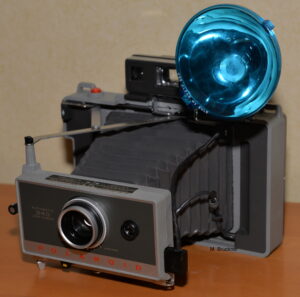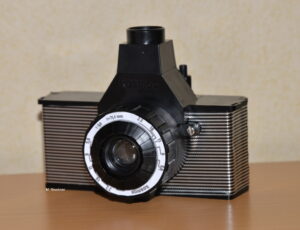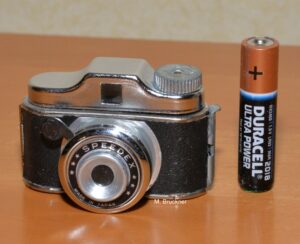Special formats
In the history of analog cameras, there are many cameras that used film formats that are unusual from today’s perspective and often no longer available. Here is a small selection.

The strange-looking Fotochrome camera was manufactured in large numbers in 1965 by the Japanese company Petri for the US-American Harrison Group, which launched the camera with a lavish advertising campaign. A direct positive material with a sensitivity of ISO 10 (ten!) was used as the film. After development, photos with a size of 5.5 X 8 cm were created. A flash for M3 flash bulbs is built in. Due to the often faulty automatic exposure control via the ring-shaped selenium cell, the small picture format without negatives and the lack of customer acceptance, this camera became one of the biggest flops in the American camera industry. Unfortunately, film material for this camera is no longer available anywhere.

The American physicist E.H. Land who introduced the first Polaroid instant camera in 1947 had more success.
The model 340 shown here has a range finder, automatic exposure control and the system flash for clear M3 flash bulbs (hence the blue reflector screen).
The film used is the FP 100 pack film, which is unfortunately no longer in production and delivers images in the format 8.5 x 10.8 cm.
Until the spread of digital cameras, the Polaroid system was the fastest way to take pictures. Even today, Polaroid photography has a high fun factor, especially among young people.

For the popular 16mm film, which was often used in film cameras, a number of small cameras came onto the market in the 1960s, which, like the Minox, wanted to benefit from the small film format. Here is the Mamiya 16 Automatic, which came to German photo shops around 1960. Later the machine was also sold by Foto-Quelle under the “Revue” trademark. The device has the dimensions 3x5x10 cm and is happily fully equipped. An exposure meter with a slide rule and aperture coupling was not a matter of course at that time. The same applies to the built-in yellow filter and the flash shoe attached to the side, including the socket. All of this is housed in a solid metal body.

When Kodak presented its 126 cassette system, which was protected by several patents and was successful, in 1963, Agfa came up with the idea of resurrecting the „Karat“ system that had already been developed in 1937 and slightly modifying it under the name „Rapid“ as an answer to the Instamatic cassette market. A simple film change that is also easy for laypeople was also propagated here. It is therefore not surprising that Rapid cameras were rather simply knitted snap boxes for photographic beginners.
The Agfa ISO-Rapid I shown here has an unspecified Parator lens and only offers two different shutter speeds for exposure control. The flash shoe with central contact is interesting, which was not a matter of course at the time. The frame counter is clearly visible on the top of the camera, and the film is transported using a rotary wheel. The picture format is

square 24 x 24 mm so that 16 pictures fit on the film. A distance setting is not provided.
The ISO-Rapid IF offered at the same time offers a built-in flash unit for FB flash bulbs in addition to a faster Isinar lens with three adjustable apertures (8-11-16). A 6 volt battery is housed in the bottom of the camera, the flash reflector can be extended and retracted using a knurled wheel.
Here, too, the negative format is 24 x 24 mm The Rapid system couldn’t hold its own against Kodak’s Instamatic cassette for long. From 1967 Agfa built its own Instamatic cameras. Rapid cartridges can be “filled” with normal 35mm film, the maximum film length is 60cm.

The Franckh’sche Verlagshandlung, known for its „Kosmos“ experimental kits, produced the Optikus from around 1968. In more than 100 experiments, from color decomposition in the prism to the effortless construction of functional devices, such as e.g. B. telescope with 15x magnification and achromatic lens, the laws of optics and photography can be learned in a playful way.
The culmination of the kit, which as far as I know had cost over 100 DM, was undoubtedly the construction of a single-lens reflex camera with interchangeable  lenses. The Agfa Rapid System was used for the film of this camera. The construction of the camera is quite tedious, since the plastic parts used, which make up the shutter mechanism, are very roughly manufactured and precise adjustment after installation is no longer possible.
lenses. The Agfa Rapid System was used for the film of this camera. The construction of the camera is quite tedious, since the plastic parts used, which make up the shutter mechanism, are very roughly manufactured and precise adjustment after installation is no longer possible.

Finally, a camera can be made that is able to expose a film with a very cloudy waist-level viewfinder and the standard lens 1:5.6/71.5 mm with two plastic lenses. If only it weren’t for the unreliable locking mechanism! The bottom line is that the plastic parts used are too stiff and have too much play, so that proper functioning cannot be guaranteed. With a more precisely fitting metal version of the locking unit, one would certainly have had more success. Likewise, the disappearance of the rapid system was certainly not planned for the manufacturer. A rather rare camera nonetheless. A few more technical details: Type: single-lens reflex camera with waist-level viewfinder Shutter speed: approx. 1/30 sec 2-element lens f: 5.6/71.5mm Lightning connection: no Tripod thread: no Strap Eyelets: Yes
Produced in Japan since the early 1930s, the mini cameras designed for 17.5 mm roll film were also exported to the West in large quantities and an almost unmanageable variety of types after the Second World War.

The Speedex shown here is one of the basic versions with a fixed focus lens and a shutter speed of around 1/30s. The AAA battery next to it is for size comparison. The correct film transport can be checked via a red window on the back.
Similar to the 120 roll film, the 17.5mm film came with paper with a frame number printed on it.

The slightly better equipped model Mycro IIIa offers not only a double exposure lock but also an aperture setting in the range of 4.5-11, a cable release connection and a cute leather case. Again, the battery is only for size comparison, these little machines do not need electricity. Unfortunately, films are no longer available for these cameras.


Another sad chapter in the history of photography is the introduction of Kodak disc film in 1982.
Originally planned to replace the „pocket format“, which was declining in sales, disc film was not able to establish itself because of its even smaller negative format (8×10.5mm) and the resulting coarse-grained enlargements.
Here is the top camera of the Kodak series, the Kodak
Disc 8000: In addition to a gold-metallic front panel, the camera offered its user an extendable close-up lens, a built-in electric flash that switched on automatically, a self-timer, a serial picture function (3 pictures in a row) and last but not least a cute little LCD clock with an alarm function in the housing cover. The optical equipment of the camera was rather modest: A fixed focus lens (12.5 mm f:2.8) should be sufficient to expose the 15 images that were arranged in a circle on the film. Exposure control was automatic.

External companies offered attachment lenses as useful accessories, which resulted in a telephoto or wide-angle function corresponding to 35mm and 70mm (for 35mm). A corresponding viewfinder lens was also installed. Despite short-term sales success, disc cameras hardly spread at first. They did not offer any significant advantages over the now similarly inexpensive compact 35mm cameras. It was also questionable from the start whether the accompanying film would exist for long. The film production ended in 1999.
Go to Digital Cameras or Home
